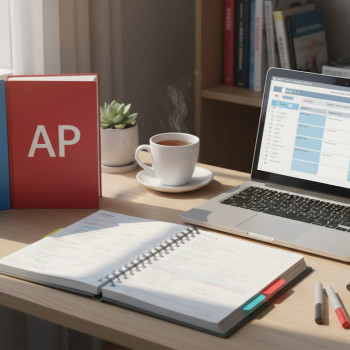Why Monthly Evidence Audits Matter for AP Students
If you’re preparing for AP exams — whether you’re juggling AP Biology, AP U.S. History, or AP Calculus — one small habit can change everything: a monthly evidence audit. Think of it as a gentle, once-a-month check-in where you gather the artifacts of your learning (notes, practice tests, lab reports, essays), decide what truly demonstrates progress, and tidy up the noise. Over time, this practice turns a chaotic pile of study materials into a high-value portfolio that saves time, sharpens focus, and makes study planning feel less like a slog and more like strategy.
The student and parent case for audits
Students gain clarity — seeing where they improved, what still trips them up, and which study methods actually work. Parents get reassurance that time and money spent on tutoring, resources, and practice are producing measurable progress. Monthly evidence audits are not about perfection; they’re about evidence-based momentum.

What Is an Evidence Audit — Step by Step
At its core, an evidence audit is a short, structured review of your recent learning artifacts. Here’s a simple monthly routine that takes 30–60 minutes and pays back hours in efficiency:
- Collect: Pull together all study artifacts from the past month.
- Tag: Label each item with subject, date, and type (e.g., practice exam, lab report, essay draft, vocabulary list).
- Score: Quickly rate each artifact for usefulness on a three-point scale: Keep (high value), Reference (maybe), or Archive (discard or long-term store).
- Action: Create 3–5 clear next steps based on what you kept — targeted practice, concept review, or a new study strategy.
- Store: File kept items in a compact, searchable system — digital or physical — and archive the rest.
Why monthly?
Doing this monthly is frequent enough to catch learning trends and infrequent enough to avoid busywork. Monthly cadence aligns well with school rhythms: unit tests, lab cycles, essay drafts, and practice exams often cluster monthly.
What to Include in Your Audit: The Essentials
When you sit down to audit, prioritize items that reveal understanding or persistent gaps. Here’s a checklist of high-impact artifacts to collect:
- Practice AP exams or full-length section diagnostics (even single-section scores matter).
- Graded essays and feedback (AP Lang, AP History, AP Psychology free-response practice).
- Lab reports and data analyses for science APs.
- Problem sets showing repeated mistakes (Calculus, Physics, Chemistry).
- Study plans, flashcard sets, and question logs (where you record mistakes and corrections).
- Teacher comments, rubrics, and returned quizzes.
- Notes from tutoring sessions — especially if you’re using personalized tutoring like Sparkl’s 1-on-1 guidance, where tutors often recommend targeted follow-ups.
Quick tip: prioritize feedback over effort
Time spent studying matters less than the feedback loop you create. An hour that produces corrected errors, teacher comments, or tutor insight is more valuable than three hours of unfocused review. Keep artifacts that contain feedback.
Deciding What to Keep vs. Archive: A Practical Framework
Not all documents are equal. Use this simple decision framework during your audit:
- Keep — Evidence of growth or recurring struggle: practice tests that show progress or consistent errors, graded essays with comments, corrected problem sets with notes.
- Reference — Useful templates and models: exemplar essays, solved step-by-step problems you’ll reuse, flashcards keyed to weak areas.
- Archive — Clutter, duplicates, or low-value worksheets: photocopies of handouts you’ll never revisit, undiagnostic busywork.
Example: AP U.S. History
Keep: an essay with teacher comments showing improvement in thesis statements; Reference: a timeline of key events; Archive: printed copies of a basic map worksheet you didn’t use.
How to Store and Organize Kept Evidence
Storage can be digital, physical, or hybrid. The most important thing is that it’s searchable and lightweight.
Digital system (recommended)
- Create a top-level folder for each AP course.
- Within each course, use folders for: Practice Tests, Essays, Labs/Problem Sets, Tutoring Notes, and Flashcards.
- Name files consistently: YYYY-MM-DD_Subject_Type_ShortTitle (e.g., 2025-03-12_APCalc_PracticeExam1_SecB.pdf).
- Use tags or comments for quick context: Mistake Type = Algebraic Manipulation; Time Spent = 45 min; Tutor = Ms. Rivera.
Physical system
- Use a single binder per course with dividers for the same categories listed above.
- At the end of each month, remove items marked Archive and scan only items you’ll truly reuse.
Hybrid approach
Scan only high-value physical artifacts (like graded essays) into your digital folders, then recycle the paper if you don’t need it for college portfolios.
How an Audit Informs Your Monthly Study Plan
An audit should end with action: a concise list of prioritized study tasks. Use the kept items to build a targeted plan.
- Identify the top 2–3 recurring error types from practice tests and schedule deliberate practice sessions focused on them.
- If several essays show weak analysis, schedule one mini-lesson each week on evidence use and practice a timed prompt.
- For labs with messy data analysis: dedicate a session to learning or relearning the statistical or graphical tools you need.
Template: 4-Point Monthly Action Plan
| Priority | Focus | Evidence | Action |
|---|---|---|---|
| 1 | Free-Response Time Management | Two timed FRQs showing incomplete responses | Practice 3 timed FRQs weekly; review rubric with tutor |
| 2 | Algebraic Manipulation Errors | Lowest problem-set scores in Calculus | Daily 20-min targeted problem set + error log |
| 3 | Vocabulary Recall | Quiz shows 70% recall on flashcards | Spaced-repetition schedule for key terms |
How to Use the Archive Intelligently
Archiving doesn’t mean deleting everything forever. It means moving low-priority items out of your active study stream so you don’t waste attention on them. Consider these archive policies:
- Short-term archive (3–6 months): items you might revisit for college applications or midyear reviews.
- Long-term archive (2–3 years): final drafts and capstone projects you might want for college portfolios.
- Backup policy: keep two copies of high-value items (cloud + local drive or cloud + physical binder).
Deletion vs. Archive
Delete duplicates and low-value worksheets. Archive exemplars, high-quality corrected essays, and practice exams that show your trajectory. Your future self will thank you when you need a quick confidence boost before an exam.
Using Evidence to Build Confidence (Not Just Scores)
One underrated benefit of this process is psychological. When you see a month-by-month record of corrected mistakes and improved scores, it builds confidence. That confidence translates into calmer test-taking and better performance.
Micro-wins to watch for
- Fewer repeated mistakes across practice sets.
- Shorter time to complete a section without loss of accuracy.
- More frequent “Aha!” moments noted in your study journal.
Making Audits Collaborative: Teachers, Tutors, and Parents
Evidence audits aren’t solitary. Invite feedback from teachers and tutors. If you work with Sparkl’s personalized tutoring, share your kept artifacts with your tutor before a session — it helps them give laser-focused support and tailor homework to your real needs.
How to present your audit to a tutor or teacher
- Send a short one-page summary: top 3 strengths, top 3 weaknesses, and the artifacts that prove them.
- Ask for specific guidance: “Which two practice problems should I do to fix this?” rather than “How do I get better?”
- Use audit findings to set measurable goals for the next month.
Tools and Templates That Make Audits Easy
You don’t need fancy software. A few simple tools will do:
- Cloud storage (Google Drive, OneDrive) for searchable digital archives.
- A spreadsheet template for your evidence log: Date, Artifact, Type, Score, Keep/Reference/Archive, Notes, Action.
- A simple naming convention and a folder structure (outlined above).
- Optional: a note app (Notion, Evernote) for tagging and linking artifacts to study plans or tutor notes.
Minimal Audit Spreadsheet Example
| Date | Course | Artifact | Score / Rating | Decision | Action |
|---|---|---|---|---|---|
| 2025-09-12 | AP Biology | Unit 2 Practice Exam | 72% | Keep | Targeted review: cellular respiration questions |
| 2025-09-20 | AP Lang | Timed FRQ #3 | Score 6/9 | Reference | Work on evidence selection; tutor review |
Common Mistakes Students Make and How Audits Fix Them
Here are typical pitfalls and the audit-based fixes:
- Keeping everything “just in case” — Audit fix: force-choice triage (Keep/Reference/Archive) reduces clutter.
- Studying without targeted feedback — Audit fix: focus on artifacts with teacher/tutor comments.
- Not tracking progress — Audit fix: a monthly log makes trends visible.
- Overreliance on practice volume rather than quality — Audit fix: prioritize corrected items and evidence of mastery.
How to Make Audits Fun and Sustainable
Routine beats motivation. Make the monthly audit something you look forward to:
- Pair it with a small reward: your favorite snack, a 30-minute break, or a quick walk.
- Turn it into a study date with a friend — swap one artifact and give each other one piece of advice.
- Celebrate micro-wins publicly (with parents or tutors) to reinforce momentum.
Image placement for a progress shot

Preparing for the Final Stretch: Audits in the Last 3 Months Before AP Exams
When you’re within three months of the exam, audits should shift from broad review to sprint mode:
- Increase the frequency of mini-audits: weekly quick checks for high-priority artifacts.
- Keep full practice exams and the associated error logs as primary evidence.
- Use your portfolio to create a final “weakness map” — the 10–15 topics that will get the most attention.
Example final sprint checklist
- Complete two full-length practice exams under timed conditions each week.
- Review every missed question and rewrite the solution until you can explain it aloud for 60 seconds.
- Finalize and rehearse essay templates, ensuring you can adapt them to prompts.
Measuring ROI: How to Know the Audit Is Working
Measure the audit’s impact with a few simple indicators:
- Practice test score trends month-over-month.
- Reduction in repeat mistakes (track via your spreadsheet).
- Shorter time to correctly solve common problem types.
- Greater confidence and reduced test anxiety reported by the student.
When to adjust your audit approach
If scores plateau for two months, change the intervention: try a different practice source, involve a tutor for targeted sessions, or switch to alternate study techniques such as interleaved practice or active recall. Personalized tutoring services like Sparkl’s can help diagnose plateaus and recommend tailored study plans and AI-driven insights to refocus effort where it matters most.
Final Thoughts: A Quiet, Powerful Habit
Monthly evidence audits are deceptively simple but profoundly effective. They transform scattered effort into purposeful practice, make growth visible, and reduce the stress of last-minute cramming. Students who make audits a habit often find that studying becomes less about panic and more about progress.
If you’re just getting started, don’t overcomplicate it. Start with one course, follow the four-step monthly routine, and keep it under an hour. Share the results with a teacher or tutor, and refine your approach. With time, you’ll build a compact portfolio that proves your readiness — and that’s exactly the kind of clarity every AP student and parent wants heading into exam season.
Quick Starter Checklist
- Schedule a recurring 45-minute slot each month for your audit.
- Collect artifacts from the last month and triage them Keep/Reference/Archive.
- Build a 4-point action plan and share it with your tutor or parent.
- Store kept items in a searchable digital folder using consistent naming conventions.
- Celebrate one improvement you can see from last month’s audit.
Good luck — and remember, steady evidence beats frantic guessing. Small monthly audits yield big results.




















No Comments
Leave a comment Cancel